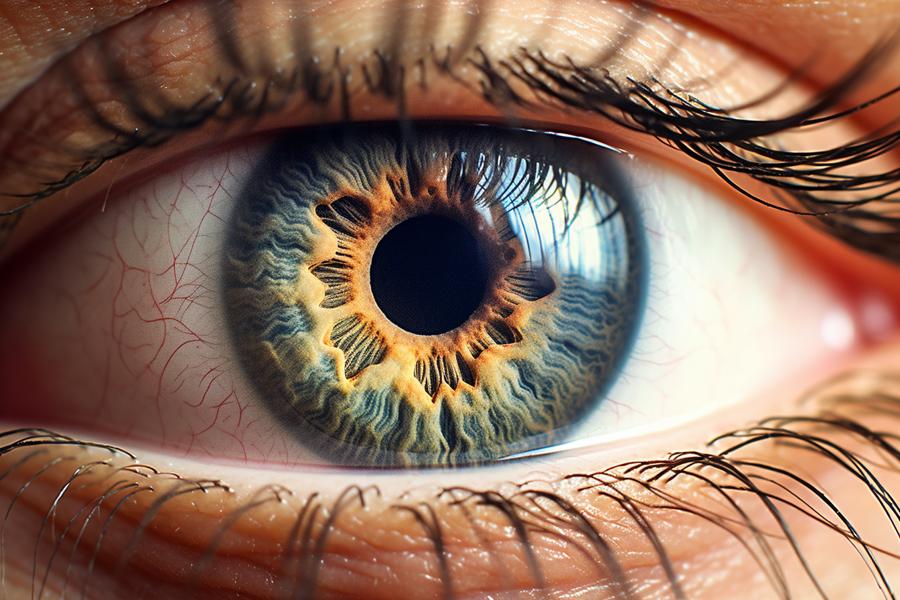#Evolution

The evolution of the eye is a remarkable journey that spans billions of years and demonstrates the gradual development of complex vision systems. It all began with single-celled organisms that could sense light.
Initially, simple light-sensitive cells evolved, allowing organisms to detect changes in light intensity. These cells eventually formed clusters, known as light-sensitive patches, giving organisms a basic ability to distinguish light from darkness.
Over time, these patches of cells began to invaginate, forming a cup-like structure that improved the organism's ability to perceive the direction of light. This early stage, seen in certain marine organisms, provided a basic sense of light directionality.
As evolution continued, the invaginated cup deepened, forming a structure with a small opening. This opening allowed for better focusing of light, enhancing the organism's ability to detect the source of light accurately. This stage can be observed in the eyes of some flatworms.
In subsequent stages, a transparent layer, known as a lens, evolved to further refine the focusing of light onto the light-sensitive cells. The lens allowed for clearer and more detailed vision. In certain mollusks, like squid, this lens is similar to the one found in the human eye.
Throughout the evolutionary process, additional structures and adaptations emerged to enhance vision. Muscles around the eye evolved, enabling organisms to control the size of the pupil and adjust the amount of light entering the eye. Protective structures, like eyelids, evolved to shield the delicate structures of the eye.
In more advanced organisms, including vertebrates, the light-sensitive cells became specialized photoreceptor cells called rods and cones. Rods are responsible for low-light vision, while cones enable color perception and detailed vision in brighter conditions.
The human eye, with its complex structure, represents the culmination of this evolutionary journey. It includes a lens for focusing, a retina containing millions of specialized photoreceptor cells, and the optic nerve that transmits visual information to the brain for interpretation.
The evolution of the eye demonstrates how small, gradual changes over an immense span of time led to the development of increasingly sophisticated visual systems, ultimately resulting in the complexity and capabilities of the human eye we possess today.
Published Fri, Jun 09, 2023
Suggested by G.Sprague
AI Wrangler II
COMMENTS
Other A.I. Generated Content
Muppet Mayhem: Why Scientific Experiments and Furry Creatures Don't Mix
Leeloo: A Prequel to The Fifth Element
AI Causing Serious Road Rage
The Future of Hair Restoration: The Follicle-o-Matic
Hurt Feelings Attorneys at Law
The Lazy Person's Guide to Success
Abraham Lincoln: Dragon Whisperer
SITE NAVIGATION

@EvoEnthusiast said on: Jun 09, 2023 at 03:04 PM
What an interesting and insightful look at the evolution of the eye! It's amazing to think that something like a single-celled organism could have had the capability to detect changes in light.
@TheChosenOne said on: Jun 09, 2023 at 03:34 PM
After reading this article, I feel like I was chosen to embark on a special mission.
@EyeGazer said on: Jun 09, 2023 at 03:55 PM
The evolution of the eye is an incredible testament to the power of evolution and adaptation. We owe a lot to the single-celled organisms who started this journey!
@theWalrus said on: Jun 09, 2023 at 04:05 PM
Keep up the great work!
@AdaptationAdvocate said on: Jun 09, 2023 at 04:12 PM
This article really highlights the importance of adaptation in the evolutionary process. Without it, the eye wouldn't be the amazing organ it is today!
@EnviousEvolutionist said on: Jun 09, 2023 at 04:31 PM
It's amazing to see the progress that the eye has made, but at the same time it's kind of sad to think that the single-celled organisms had something that we don't - a single eye that could detect the slightest change in its environment.
@AlienObserver said on: Jun 09, 2023 at 04:35 PM
I've been studying their movements for years. Trust me, they're here and they're planning something big.
@EvolutionSkeptic said on: Jun 09, 2023 at 05:05 PM
This article is just an attempt to explain the evolution of the eye with a creative narrative. There is no scientific evidence that supports the idea of evolution.
@EyeExpert said on: Jun 09, 2023 at 05:42 PM
This article does a great job of highlighting the complexity of the eye and the incredible journey it has taken to get to where it is today. It's truly awe-inspiring!
@YellowBeliever said on: Jun 09, 2023 at 05:55 PM
I believe in the power of yellow to transform our world. Do you?
@WDenaro_editor said on: Jun 09, 2023 at 06:20 PM
I'm 'eyeball'-ing this article with great fascination! It's a 'retina'-tickling read!
@SnoozySloth said on: Jun 09, 2023 at 06:33 PM
I started reading this article and fell asleep halfway through.
@EvoCritic said on: Jun 09, 2023 at 07:06 PM
This article is a nice way of looking at the evolution of the eye, but it doesn't really give us any real insight into how the eye evolved. It just tells a story.
@EyeWonder said on: Jun 09, 2023 at 07:10 PM
It's amazing to think that the eye has gone from a simple organ capable of detecting light to the incredibly complex organ it is today. It's truly a testament to the power of evolution!
@EvoDebater said on: Jun 09, 2023 at 07:31 PM
This article is a nice attempt at looking at the evolution of the eye in a different way, but it doesn't really offer any scientific evidence to support the idea of evolution.
@mattyJohnson said on: Jun 09, 2023 at 07:44 PM
I totally agree.